Biological Control of Parthenium
Biological Control of Parthenium
- What is parthenium?
- Why parthenium is a dangerous weed?
- What is biological control?
- How biological control works?
- Biological control by Mexican beetle (zygogramma bicolorata) in India
- Biology of Mexican beetle
- How beetles kill the parthenium?
- Efforts of DWSR
- Collection for augmentation of the beetles
- Can beetle harm other crops?
- How many beetles should be released?
- Biological control by competitive plants
What is parthenium?

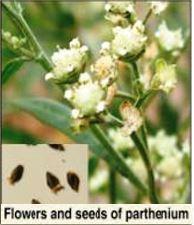 Parthenium hysterophorus L., commonly known as carrot weed, white top or congress grass in India, is an herbaceous, erect and annual plant belonging to the family Asteracae (compositae). It is most popularly known as gajar ghas due to its appearance like carrot plant.
Parthenium hysterophorus L., commonly known as carrot weed, white top or congress grass in India, is an herbaceous, erect and annual plant belonging to the family Asteracae (compositae). It is most popularly known as gajar ghas due to its appearance like carrot plant.
The origin of parthenium is considered to be from Mexico, America, Trinidad and Argentina. After noticeable occurrence of parthenium in Pune (Maharashtra) in 1955, it has spread like a wild fire throughout India. At present parthenium has invaded about 35 million hectares of land on Indian.
It is a nuisance on road sides and railway tracks, vacant lands, wastelands, industrial areas, on the sides of open drainage system and irrigation canals besides invading agricultural crops, orchards and forest area.
It mainly spreads through seeds. A single plant can produce about 5000 – 25000 seeds. The seeds are very small in size and light in weight.
Why parthenium is a dangerous weed?
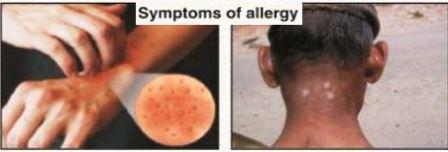 In general, parthenium is a poisonous, pernicious, problematic, allergic and aggressive weed posing a serious threat to human beings and livestock.
In general, parthenium is a poisonous, pernicious, problematic, allergic and aggressive weed posing a serious threat to human beings and livestock.
In India and Australia, this weed has been considered as one of the greatest source of dermatitis, asthma, nasal-dermal and nasal-bronchial types of diseases.
Besides ill effects, it also causes several other problems like blockage of common pathways and reduces the aesthetic values of parks, gardens and residential colonies.
What is biological control?
Biological control is the intentional manipulation of natural enemies by man for the purpose of controlling harmful weeds. Biological control seldom means complete eradication of the unwanted organism, but rather maintaining its population at lower than average that would occur in the absence of the bio-control agent. Parthenium is mainly a weed of waste and fallow land, hence, biological control is the most economical and practical way to keep the weed under check.
How biological control works?
Under the biological control programme, host specific bio agents from the native home of the weed are imported into other countries, where the weed had entered and became invasive. Biological control is inexpensive and poses no threat to non-target organisms, environment and biodiversity. It is self-perpetuating and can spreads by its own while other control measures require inputs periodically. It is easy to integrate with other control measures.
Biological control by Mexican beetle (zygogramma bicolorata) in India
Based on well documented success by Mexican beetle, Zygogramma bicolorata Pallister (Coleoptera: Chrysomelidae) in other countries where they were introduced, beetles were imported in 1982 from Mexico to Bangalore. Detailed host-specificity tests under quarantine conditions confirmed the safety of Z. bicolorata to cultivated crops in the country. Thereafter, field releases were initiated in Bangalore and India.
Biology of Mexican beetle
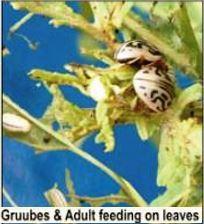
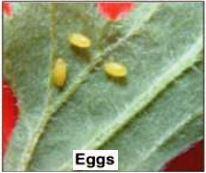 Beetles are off-white or light reddish in colour with dark brown longitudinal markings on the elytra, measuring about 6 mm. in length. Light yellow eggs are laid generally on ventral side of the leaves and hatch in 4-7 days. There are four in stars. The grubs feed for 10-15 days on the leaves and on maturity enter into soil and pupate below up to 15 cm depth. Beetles emerge after 8-12 days. The beetle completes its life-cycle in 27-32 days. - Insect completes 4-5 generations from June to October in natural conditions. The female can lay up to 2500 eggs during its lifespan. The beetle remains most active in the field during the rainy season between June to October but stages of Z. bicolorata may be encountered in summer and winter season depending on the moisture and temperature.
Beetles are off-white or light reddish in colour with dark brown longitudinal markings on the elytra, measuring about 6 mm. in length. Light yellow eggs are laid generally on ventral side of the leaves and hatch in 4-7 days. There are four in stars. The grubs feed for 10-15 days on the leaves and on maturity enter into soil and pupate below up to 15 cm depth. Beetles emerge after 8-12 days. The beetle completes its life-cycle in 27-32 days. - Insect completes 4-5 generations from June to October in natural conditions. The female can lay up to 2500 eggs during its lifespan. The beetle remains most active in the field during the rainy season between June to October but stages of Z. bicolorata may be encountered in summer and winter season depending on the moisture and temperature.
How beetles kill the parthenium?

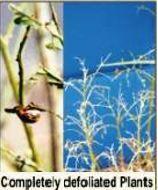 Both adults and larvae are capable to feed on parthenium leaves. Larvae after hatching start to feed on soft growing leaves, first attacking the terminal and axillary buds and later the leaf blades, thus checking completely the plant growth and flower production.
Both adults and larvae are capable to feed on parthenium leaves. Larvae after hatching start to feed on soft growing leaves, first attacking the terminal and axillary buds and later the leaf blades, thus checking completely the plant growth and flower production.
Adults voraciously defoliate the plant. Immature flowers are cut by the beetles in an effort to chew soft tissues beneath the flowers. Completely defoliated plants start to show die back symptoms and gradually get killed. Small and succulents plants are more vulnerable to larvae and beetles attack and are nipped in the bud. In many states of India, beetle has establishment and contributing to control several hundred hectares of land fully infested with parthenium. At many places, beetle even controlled parthenium in the crop fields where insets searched the parthenium amidst the crop and devoured it.
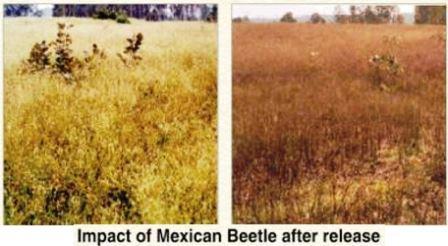 Since the first release in the field in 1984 at Bangalore, the beetle has well established in most of the south India and many parts of central and north India. In a very conservative estimate, it is calculated that the beetle has already spread in about 7 million hectares of land which amounts to be about 20% area of the estimated 35 million hectares land infested with the parthenium.
Since the first release in the field in 1984 at Bangalore, the beetle has well established in most of the south India and many parts of central and north India. In a very conservative estimate, it is calculated that the beetle has already spread in about 7 million hectares of land which amounts to be about 20% area of the estimated 35 million hectares land infested with the parthenium.
Initially it was feared that beetle will not be able to survive in the extreme low and high temperature of north and central India but it has betrayed this assumption and beetle has established well in many parts of Haryana, Punjab, Uttar Pradesh,Uttaranchal, Madhya Pradesh, Tamilnadu, Karnataka, Andhra Pradesh, Himanchal Pradesh and Maharashtra.
Efforts of DWSR
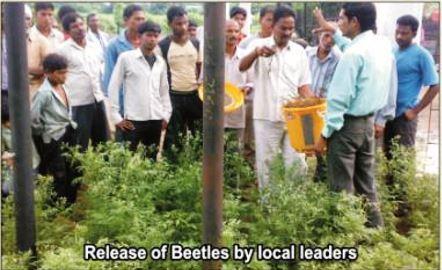 Directorate of Weed Science Research (DWSR) has intensified biological warfare against parthenium involving Krishi Vigyan Kendra, NGOs, local residents and farmers. At many places in M.P. beetles were released in the programme arranged with the collaboration of NGOs, residential societies, clubs, municipalities etc., involving local leaders. DWSR has also supplied nucleus cultures of the beetle to different All India Coordinated Research Programme on Weed Control (AICRPWC) Centres in 14 states apart from supplying to KWKs, farmers, municipalities and interested persons in almost all the states.
Directorate of Weed Science Research (DWSR) has intensified biological warfare against parthenium involving Krishi Vigyan Kendra, NGOs, local residents and farmers. At many places in M.P. beetles were released in the programme arranged with the collaboration of NGOs, residential societies, clubs, municipalities etc., involving local leaders. DWSR has also supplied nucleus cultures of the beetle to different All India Coordinated Research Programme on Weed Control (AICRPWC) Centres in 14 states apart from supplying to KWKs, farmers, municipalities and interested persons in almost all the states.
DWSR also provides consultancy on Parthenium management to private and government agencies. DWSR released about 60 lakh beetles under consultancy programme in different blocks and circles of Nagpur region. To obtain the beetle culture free of cost, requests may be sent to Director DWSR in June–July.
Collection for augmentation of the beetles
The beetles can easily be collected from the established sites during June to September. Collection can be made in ordinary polythene or plastic containers that are perforated with a needle. Upper parthenium twigs without leaves should be placed inside the polythene to avoid the shrinking and to provide resting place for the insect. If the insects have to be carried over long distances, it is better to avoid leaves to prevent moisture condensation and fungal growth, which can cause insect mortality. Care must be taken to make the initial releases on small and succulent growth of parthenium in undisturbed areas away from human habitations. Initial release should be avoided in cultivated land because ploughing of land may disturb the pupation process hence poor survival and subsequent establishment. Low lying areas prone to water logging should also be avoided because pupation takes place in soil. The ideal time for carrying out releases will be June to August when plenty of fresh parthenium plants are available in nature. There is no benefit in undertaking releases between Novembers to May when they normally do not breed. However, during this period, beetle can be released over parthenium near the water sources
Can beetle harm other crops?
There are no chances or harming other crops as beetle is host specific. It cannot survive on food other than Parthenium. A controversy emerged on the feeding status of Z. bicolorata sunflower ended in 1999, based on the report of “Fact Finding Committee" constituted by Indian Council of Agricultural Research.
How many beetles should be released?
One adult was found to bring defoliation of a single parthenium plant in 6-8 weeks. Therefore, if releases are to be carried out at this rate, about 0.4. to 0.7 million insects will be required per hectare, as the weed density varies between 40 to 70 plants per square metre. In practice, it is neither possible nor necessary to release so many insects as they are capable of multiplying rapidly. Releases of about 500-1000 beetles can bring about establishment and eventual control. Once plants are eaten up in the release spot the insects migrate into adjacent areas. Taking this into consideration, a number of release spots can be selected in a particular place or city, which can act as a focal point.
More releases mean quicker establishment of the beetle, Therefore, for better control, do as many release as affordable during first couple years of introduction. This method reduces the time in years for the beetle to build up population and help the beetles to disperse fast. The least affordable approach is to introduce one or two releases into infested area and do nothing more.
Biological control by competitive plants
 Cassia tora commonly called “Chakoda" and marigold are capable to replace Parthenium by broadcasting of seeds during February–April in the Parthenium infested area.
Cassia tora commonly called “Chakoda" and marigold are capable to replace Parthenium by broadcasting of seeds during February–April in the Parthenium infested area.
Plenty of seeds of C. tora may be collected easily during October-November.
Many Parthenium infested sites have been managed by use of this technique.
Last Modified : 5/10/2022
This topic provides information about Mexican beet...
This topic covers the Information related to Integ...
